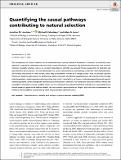Files in this item
Quantifying the causal pathways contributing to natural selection
Item metadata
| dc.contributor.author | Henshaw, Jonathan M. | |
| dc.contributor.author | Morrissey, Michael B. | |
| dc.contributor.author | Jones, Adam G. | |
| dc.date.accessioned | 2020-10-16T16:30:04Z | |
| dc.date.available | 2020-10-16T16:30:04Z | |
| dc.date.issued | 2020-10-12 | |
| dc.identifier | 270419073 | |
| dc.identifier | 282c62af-f52e-4609-a10a-b56c2adec8d0 | |
| dc.identifier | 000576762100001 | |
| dc.identifier | 85092356408 | |
| dc.identifier.citation | Henshaw , J M , Morrissey , M B & Jones , A G 2020 , ' Quantifying the causal pathways contributing to natural selection ' , Evolution , vol. Early View . https://doi.org/10.1111/evo.14091 | en |
| dc.identifier.issn | 0014-3820 | |
| dc.identifier.other | RIS: urn:8757E3B50D051E94C8ECB9969CE436F3 | |
| dc.identifier.uri | https://hdl.handle.net/10023/20793 | |
| dc.description | Funding: MBM is supported by a University Research Fellowship from the Royal Society (London). Open access funding enabled and organized by Projekt DEAL. | en |
| dc.description.abstract | The consequences of natural selection can be understood from a purely statistical perspective. In contrast, an explicitly causal approach is required to understand why trait values covary with fitness. In particular, key evolutionary constructs like sexual selection, fecundity selection, and so on, are best understood as selection via particular fitness components. To formalise and operationalise these concepts, we must disentangle the various causal pathways contributing to selection. Such decompositions are currently only known for linear models, where they are sometimes referred to as ‘Wright's rules’. Here, we provide a general framework, based on path analysis, for partitioning selection among its contributing causal pathways. We show how the extended selection gradient – which represents selection arising from a trait's causal effects on fitness – can be decomposed into path‐specific selection gradients, which correspond to distinct causal mechanisms of selection. This framework allows for non‐linear effects and non‐additive interactions among variables, which may be estimated using standard statistical methods (e.g. generalized linear (mixed) models or generalized additive models). We thus provide a generalisation of Wright's path rules that accommodates the non‐linear and non‐additive mechanisms by which natural selection commonly arises. | |
| dc.format.extent | 15 | |
| dc.format.extent | 510433 | |
| dc.language.iso | eng | |
| dc.relation.ispartof | Evolution | en |
| dc.subject | Causal derivative | en |
| dc.subject | Causality | en |
| dc.subject | Path analysis | en |
| dc.subject | Structural equation modelling (SEM) | en |
| dc.subject | QH301 Biology | en |
| dc.subject | DAS | en |
| dc.subject.lcc | QH301 | en |
| dc.title | Quantifying the causal pathways contributing to natural selection | en |
| dc.type | Journal article | en |
| dc.contributor.sponsor | The Royal Society | en |
| dc.contributor.institution | University of St Andrews. School of Biology | en |
| dc.contributor.institution | University of St Andrews. Centre for Biological Diversity | en |
| dc.identifier.doi | 10.1111/evo.14091 | |
| dc.description.status | Peer reviewed | en |
| dc.identifier.grantnumber | URF/R/191012 | en |
This item appears in the following Collection(s)
Items in the St Andrews Research Repository are protected by copyright, with all rights reserved, unless otherwise indicated.

